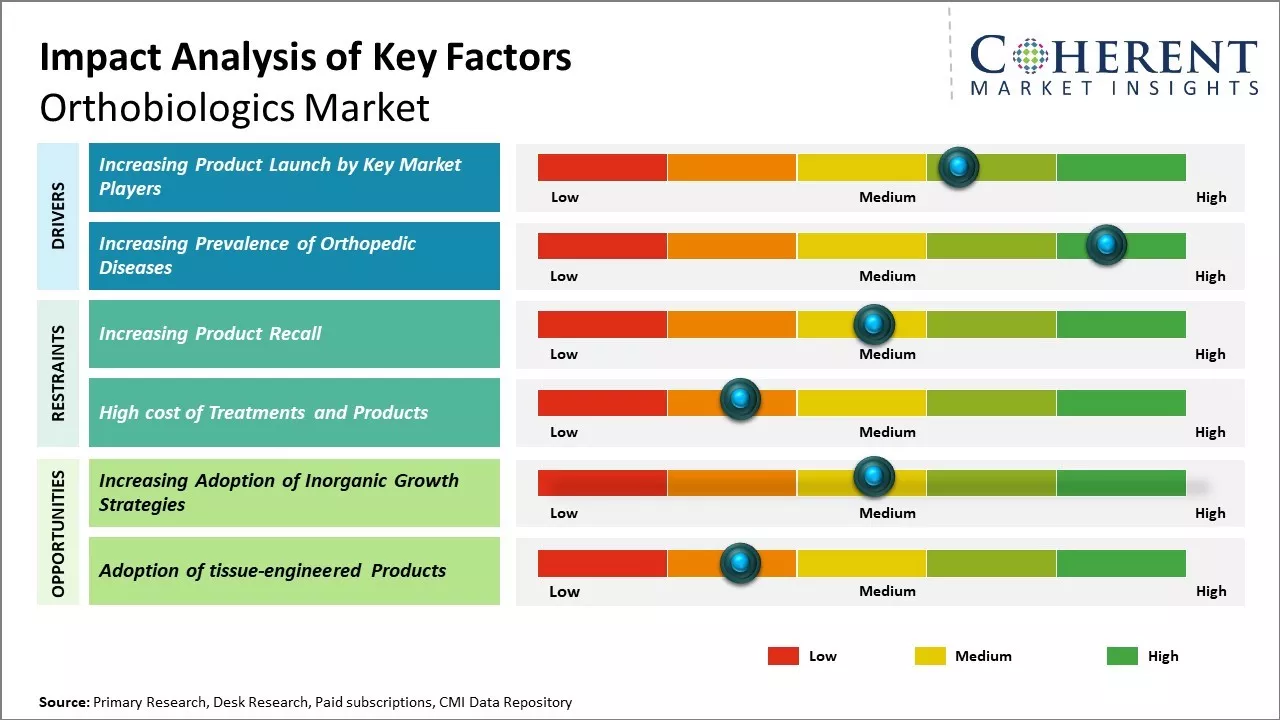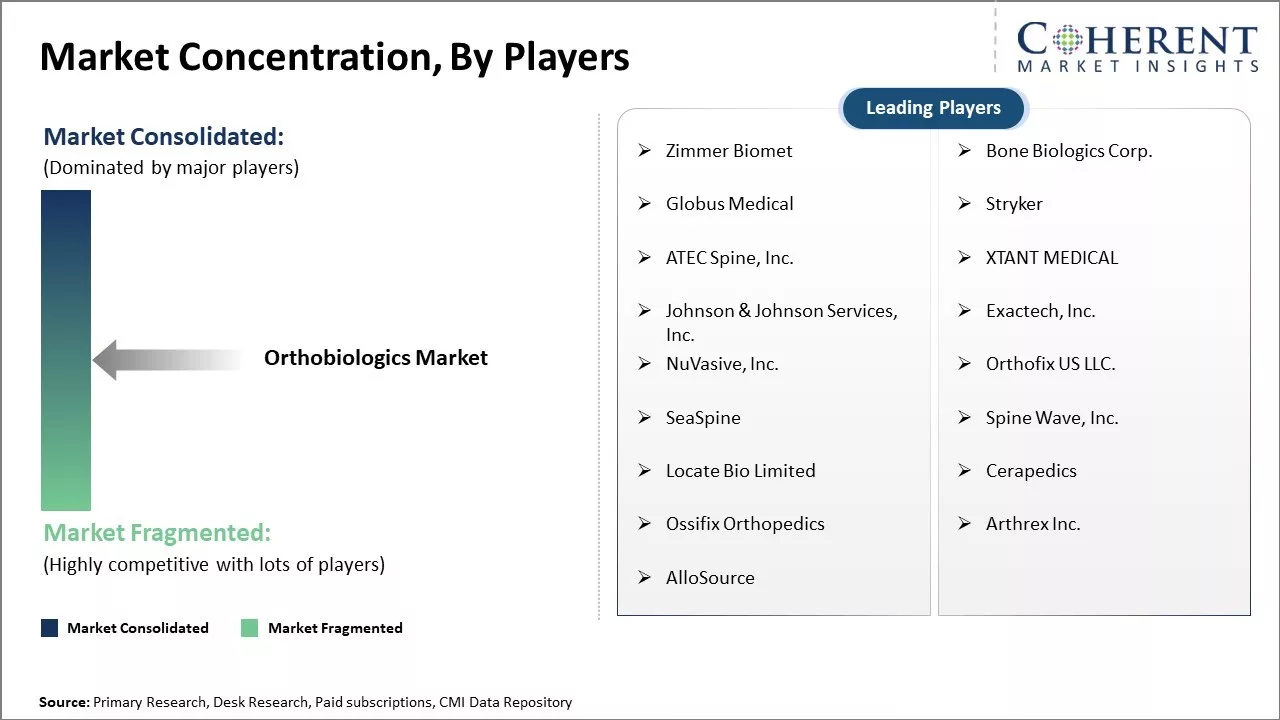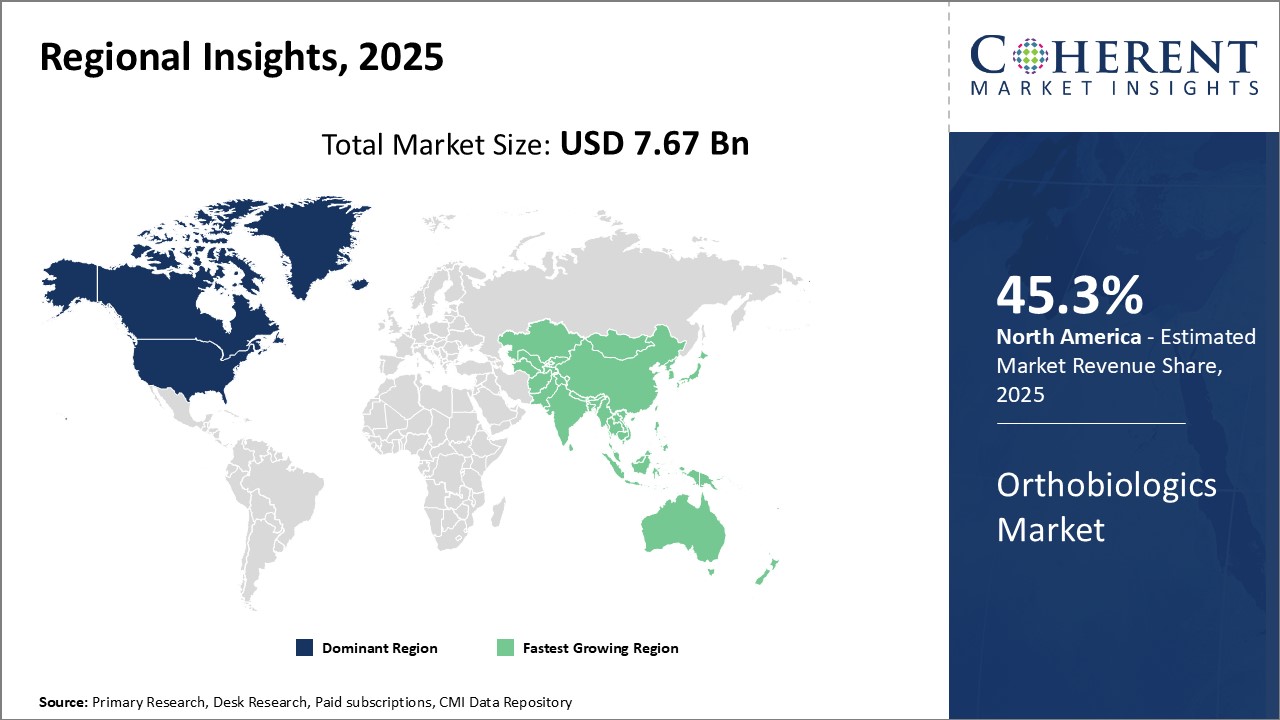The Global Orthobiologics Market size is estimated to be valued at USD 7.67 Bn in 2025 and is expected to reach USD 11.85 Bn by 2032, exhibiting a compound annual growth rate (CAGR) of 6.4% from 2025 to 2032.

To learn more about this report, Download Free Sample
The orthobiologics market demand is predicted to grow exceedingly during the review period. Some motivating factors include the increasing older population, more chronic health issues, and rising sports injuries. Moreover, lower chances of disease transmission and less invasive procedures associated with orthobiologics compared to traditional therapies are raising their demand. In addition, the enduring progress of novel products with greater therapeutic efficacy is anticipated to propel growth further. On the other hand, expensive costs relative to other available treatments and strict regulations are barriers that hinder growth.
|
Event |
Description and Impact |
|
Aging Population and Increasing Prevalence of Orthopedic Disorders |
|
|
Technological Advancements in Orthobiologics |
|
|
Regulatory Landscape and Reimbursement Policies |
|
Uncover macros and micros vetted on 75+ parameters: Get instant access to report

To learn more about this report, Download Free Sample
The Increasing prevalence of diseases and conditions has been on the rise over the past few decades. As lifestyle patterns changed with increased sedentary jobs and less physical activity, obesity rates surged dramatically impacting musculoskeletal health. According to studies, obesity significantly increases the risk of developing osteoarthritis, one of the most common orthopedic ailments affecting mobility and quality of life especially in the geriatric population.
Similarly, the risks of bone fractures, knee replacements, and spinal disorders are heightened due to excess weight. With overall improvement in life expectancy worldwide. Old age itself is a risk factor for osteoarthritis and osteoporosis as the regenerative abilities of the body slows down with time. Moreover, weight-bearing and repetitive physical activities performed throughout lifetime often manifest their effects on the bones and joints only later in life. Seniors are also prone to fall-related injuries like hip fractures
The adoption of inorganic growth strategies such as product launches by key market players is expected to drive the global orthobiologics market growth over the forecast period. For instance, in July 2022, Ossifix Orthopedics, a subsidiary of Umbra Applied Technologies Group, Inc., a medical technology company, announced that it had launched crunch, a demineralized bone matrix that contains cancellous bone fragments to provide the osteoconductive scaffolding to promote new bone growth. This product launch will expand its suite of orthopedic products
Increasing agreements among key market players are expected to offers lucrative opportunities in the market over the forecast period. For instance, in August 2022, Orthofix Medical Inc., a medical device company with a focus on spine and orthopedics, announced a strategic partnership agreement with CGBio, a developer of innovative, synthetic bone grafts currently used clinically in Asia Pacific for spine, orthopedic, trauma, and dental software. The two companies will work together for the clinical development and commercialization of Novosis recombinant human bone morphogenetic protein-2 (rhBMP-2) bone growth materials and other future tissue regenerative solutions for the U.S. and Canadian markets
The product type segment includes bone allograft, machined bones, demineralized bone matrix, synthetic bone substitutes, bone morphogenetic protein (bmp), and others. The bone allograft sub-segment is estimated to hold 33.9% of the Orthobiologics Market share in 2025 owing to its advantages over synthetic substitutes. Bone allografts are the most preferred option for orthopedic procedures like spinal fusion due to their osteoinductive properties that aid in new bone formation.
Compared to synthetic substitutes, bone allografts provide a more physiological healing environment and help achieve long term fusion through remodeling. Advancements in allograft processing have also addressed safety concerns related to disease transmission, making them safer and readily available. Moreover, bone allografts elicit a more natural healing response from the body as compared to synthetic bone graft substitutes. This factor has been a major driver for the growth of the bone allograft segment.
Developments in bone processing technologies that efficiently maintain the biological properties and microstructures of donated bones further support the increasing demand for bone allografts in orthopedic surgical procedures.
The application segment includes spinal fusion, trauma fixation, reconstructive joint surgery, and others. The spinal fusion sub-segment is estimated to hold 37.9% of the Orthobiologics Market growth share in 2025 owing to the rising prevalence of spinal disorders globally. Conditions like degenerative disc disease, spondylolisthesis, spinal stenosis, and spinal deformities lead to severe back pain and neurological compromise.
Spinal fusion surgery offers clinical benefits like reduced pain, restored stability, and improved neurological function in patients with unstable spinal conditions. It is gradually becoming the standard of care for spine pathologies warranting surgical intervention. The availability of advanced interbody fusion devices, bone graft substitutes, and fixation systems has further boosted the adoption of spinal fusion as a preferred technique for correcting spinal deformities.
The end user segment includes hospitals, orthopedic clinics, ambulatory surgical centers, and others. The hospitals sub-segment is estimated to hold 40.4% of the market share in 2025 owing to their advanced infrastructure and concentration of specialty orthopedic surgeons. Well-equipped operation theatres, intensive care facilities, and in-house rehabilitation services enable complex orthobiologics procedures like spinal fusions to be performed safely under hospital settings.
Expanding healthcare infrastructure in developing nations, favorable government initiatives towards boosting healthcare access, and rising medical tourism are fueling the demand for orthopedic services within hospitals. Preference for hospitals also stems from the fact that most orthobiologics procedures require care beyond stand-alone clinics during the early postoperative period. Moreover, large patient volumes allow for cost-saving through bulk procurement of orthobiologics products in hospitals. These factors have established hospitals as the key end-users for orthobiologics.

To learn more about this report, Download Free Sample
North America is expected to contribute the highest share of the global orthobiologics market trend in 2025, accounting for around 45.3% of the total market. This dominance is due to strong investments in research and development, favorable reimbursement policies, and a well-established healthcare infrastructure. The region also benefits from the presence of innovative domestic players who continuously expand their product portfolios, intensifying competition and accelerating new product launches. Additionally, North America acts as a key export hub with companies establishing global footprints.
Asia Pacific is projected to be the fastest growing region in the global orthobiologics market by 2025. Rapid economic development, increasing healthcare expenditures, and rising awareness about advanced treatments in countries such as China and India have driven the surge in orthopedic surgeries. Local manufacturers have enhanced production capabilities to meet both domestic and export demands, reducing dependency on imports. Supportive government regulations and the emergence of specialized hospitals and bone banks further bolster market growth.
The United States leads North America’s orthobiologics market, supported by its advanced healthcare infrastructure and substantial investments in research and development. The presence of major research universities fosters continuous innovation, enabling the U.S. to maintain a competitive edge in developing advanced orthobiological solutions.
In the Asia Pacific region, China stands out as the dominant country in the orthobiologics market. Its large patient population and rapidly expanding healthcare infrastructure drive strong demand for orthobiologics. Additionally, China’s growing emphasis on innovation and clinical research is accelerating product development and adoption, positioning it as a key growth hub in the region.
| Report Coverage | Details | ||
|---|---|---|---|
| Base Year: | 2024 | Market Size in 2025: | USD 7.67 Bn |
| Historical Data for: | 2020 To 2024 | Forecast Period: | 2025 To 2032 |
| Forecast Period 2025 to 2032 CAGR: | 6.4% | 2032 Value Projection: | USD 11.85 Bn |
| Geographies covered: |
|
||
| Segments covered: |
|
||
| Companies covered: |
Zimmer Biomet, Bone Biologics Corp., Globus Medical, Stryker, ATEC Spine, Inc., XTANT MEDICAL, Johnson & Johnson Services, Inc., Exactech, Inc., NuVasive, Inc., Orthofix US LLC., SeaSpine, Spine Wave, Inc., Locate Bio Limited, Cerapedics, Ossifix Orthopedics, Arthrex Inc., and AlloSource |
||
| Growth Drivers: |
|
||
| Restraints & Challenges: |
|
||
Uncover macros and micros vetted on 75+ parameters: Get instant access to report
*Definition: Orthobiologics use body’s own cells and healing factors to reverse the effects of orthoarthritis and accelerate the healing of tendon and ligament injuries (rotator cuff tendonitis, ankle sprain, etc.). Orthobiologics involve substances that help the body to heal more quickly. They can improve the healing of injured muscles, tendons, and ligaments and help to repair damage from osteoarthritis. These products are made from substances that are naturally found in body. Stem cells are special cells in body that can turn into other types of cells. During the healing process, stem cells are called to the area of body that needs to repair.
Share
Share
About Author
Komal Dighe is a Management Consultant with over 8 years of experience in market research and consulting. She excels in managing and delivering high-quality insights and solutions in Health-tech Consulting reports. Her expertise encompasses conducting both primary and secondary research, effectively addressing client requirements, and excelling in market estimation and forecast. Her comprehensive approach ensures that clients receive thorough and accurate analyses, enabling them to make informed decisions and capitalize on market opportunities.
Missing comfort of reading report in your local language? Find your preferred language :
Transform your Strategy with Exclusive Trending Reports :
Frequently Asked Questions
Joining thousands of companies around the world committed to making the Excellent Business Solutions.
View All Our Clients